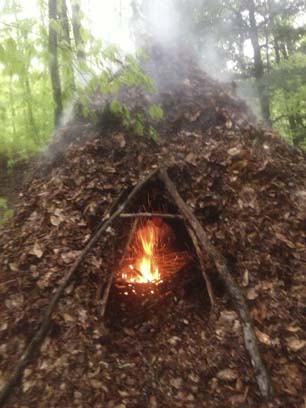This story took place at the Wild Nature Project’s Oldenburg Youth Programs of Autumn 2014. The above picture was gleaned from this lovely website, which, if you scroll down a little, gives more detailed instructions on how to build the shelter I talk about in the story you’re about to read.
Cold. Wet. Brown. In a nutshell, autumn in Indiana. Delightful.
But today, one of those rare days, it’s really, truly beautiful. A brisk wind blows through the trees crowned with lemon yellow and deep gold, interspersed with sunset orange and blood scarlet. The dappled rug of the forest floor is outspread alongside creeks and old logging trails in these older woods, crisp leaves crunching under booted feet.
Our little group of roughly eight people trundles through the autumn, up a ravine wall. In these classes, distances that regular people would traverse in five minutes take roughly twenty, due entirely to the amount of times we stop and ogle some kind of new mystery. This class used to only get a chance to come out here once a month; we learned to make the most of it.
Today there’s only the usual amount of about several hundred stops to contemplate tracks and scat alongside a creek, perhaps a plant we’ve never seen before, the husk of a crawdad that once lived under the rocks we’re crossing right now. This land is chock-full of things none of us has ever seen before, even Kevin and Monique, who have been walking the woods for years.
And when we finally make it to the top of the ravine where all our previous meals out here have taken place, we’re informed that today we’re building a shelter.
Shelters in these classes are different than anything else I’d ever known. For years, I have been told in these classes that the only things I need are shelter, fire, water and food to survive and thrive in the wild places of our planet, and now I’m learning how to use these four building blocks of surthrival alongside the beginnings of the way of the scout.
The children of the village are observed from birth, and the ones to become scouts are selected for training at the young age of seven or eight years – the age when I started learning. A scout’s early training is far more rigorous than creek wanders and circle games, however, and by the time they become a full scout they are the eyes and ears of the tribe, able to move undetected even in broad daylight.
And what would a scout sleep in? Why, a perfectly camouflaged lean-to that can disappear in a span of five minutes, of course. Thus the myriad of debris shelters that I’ve learned how to build; sometimes alone, sometimes with others. I’ve used them on survival trips, on solos, at workshops, at home; some built to last only a day, some intended to last throughout all four seasons and then some. All returned to the earth once their purpose has been fulfilled.
Today, we’re building a debrispee.
Yes, I laughed the first time I heard it. I still giggle inside, but this tepee built with forest debris – leaves, branches, logs, everything – has long since proved its steadfast effectiveness to me. Building one here, I know, will make it feel much more like our place, rather than a happened-upon clearing surrounded by fallen trees.
The first step of building this shelter takes us across a ridge on a hunt for a set of at least three perfect split-ended poles, each with an end in the shape of a Y that can interlock with the other two. Next, the easier-to-find poles, sans Y-shape, that really make the tepee shape look like a tepee when they’re leaned up against the interlocking peak of the structure.
A good chunk of our time is taken up by finding the logs that we stack in a circle, overlapping the ends so they stay steady and create a backrest all around the firepit in the center of our shelter. Not only serving as a chair, this knee-high log-cabin arrangement will, once stuffed with leaves, reflect heat in the wintertime, creating a very effective bubble of warmth.
I’ve heard stories of groups building one of these eagles’ nests (as they are known) and stripping slowly down to their tee-shirts until realizing that oh no, it’s still fifteen degrees outside and far from gathering firewood, they’re still gathering their shed layers from around the fire.
Step four consists of gathering the rather obtusely named “lattice”, also known as any and every outrageously twiggy branch you can get your paws on. These go atop the actual tepee structure, hitherto constructed of nothing but long, relatively straight poles. On top of these go leaves. And after that, more leaves. Think you have enough leaves to withstand a thunderstorm? Think again. Add more leaves.
That day, we ate lunch under a roof we built ourselves. Not finished by any means, but it was ours, and we were happy with it.
This shelter first came into being nearly an entire year ago. As far as I know, it’s still standing. It’s still waiting for us to come back this fall, to light a new fire in that firepit and share our gratitude and our stories inside its walls.
Want to join us?
